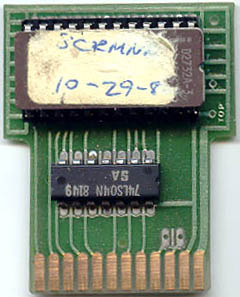"Block moving game" (partially found builds of cancelled Atari 2600 game from Activision; 1983)
A photo of the later build's cartridge, taken from the Atariprotos website.
Status: Partially Found (only 2 prototypes have been found; the amount of prototypes made for this game remains unknown)
The "block moving game" is a placeholder name for an unidentified unreleased Atari 2600 game that was being developed sometime in 1983. The game has the "Activision" logo at the bottom left corner as is usual, but it is currently unknown as to who at Activision was working on the game.[1]
Gameplay
The game includes 4 game modes of sorts, each revolving around a screen filled with colored blocks. The goal for the first 2 game modes is to move the blocks around to make the blocks line up in each row from light to dark, with red on top & purple on the bottom as shown when the game starts up. However, it is not an easy task as you play as a single block that moves one by one & the further away from the top/bottom/left/right of each column/row you're at, the more blocks that will move(for examples, if you have your block move right & the right of that row is 5 blocks away, then 5 blocks will move). Pressing the fire button when playing will open up a screen, in which the blocks in the correct positions are colored black, a color that is otherwise unseen on the blocks.
There are 4 game modes in the later build(the earlier build only has 2 game modes), which include a randomized mode, a fixed mode, a weird mode where they're all lined up perfectly & you gain points by moving around & a demonstration mode, in which the board begins empty, but then gets filled up by the sliding blocks.
History & Availability
According to the main Atariprotos page for this game, it was allegedly found in a salvage yard in 1998 by Ben Liashenko alongside a prototype of Hard Head[2], which at the time was also unidentified.[3] The prototype that Ben found is presumed to be that of the later build that contains sound & has 4 game modes on it. However, an earlier prototype has surfaced sometime ago, whose source is currently unknown. The earlier bound has only 2 game modes on it, no sound at all, & will crash if moving a square to the edge while the cursor is at the center of the screen.[4] It is currently unknown if there are any other prototypes of this game out there, such as a theoretical PAL-coded prototype similar to a Hard Head prototype that surfaced on eBay UK in 2017[5].
Similar to Hard Head, the programmer of this game has yet to be identified, with no one who worked at Activision back in the early 1980s known to have taken credit for making this game at any point. Additionally, whereas Hard Head was eventually identified with the proper title thanks to said eBay UK prototype, it is still unknown as to what this game would've been titled. The prototypes contain a label on them that says "SCRMNN", alongside "10-22-82" on the earlier build & "10-29-82" on the later build, despite both saying "Copyright 1983" in-game, suggesting that it was being coded in late 1982, but was set for release in possibly early 1983. It is currently unknown as to what "SCRMNN" really means, but some have suggested that it means "Screen manipulation", which only matches a little bit of the gameplay as the player never really gets to "manipulate" the screen.
It is currently unknown as to why Activision cancelled the game. One explanation said on Atariprotos was that the game didn't live up to the standards of Activision at the time, being not all that fun in comparison to released titles such as H*E*R*O, Frostbite, Crackpots, Keystone Kapers & especially Pitfall!, which are considered among their best Atari 2600 games. It may have also been too difficult or boring for most players out there, who would've wanted something more action-like. Another possible reason would be due to the rather niche premise, which would've been a very hard sell to even puzzle game consumers, especially around the time of the North American video game crash.
References
External Links
- The Atarimania page for the game.
- The AtariAge page for the game.
- An AtariAge page for this game & other Activision Atari 2600 prototypes
See Also
- Birthday Mania (found rare Atari 2600 game; 1984)
- Circus Charlie (lost build of cancelled Atari 2600 port of arcade action-platformer; 1984)
- The Core (partially lost Atari 2600 game; 1999-2001)
- Cosmic (partially found Atari 2600 game; existence unconfirmed; dates unknown)
- Crazy Cars (lost Atari 2600 port of Amiga game; existence unconfirmed; 1990)
- Edu Games (lost Atari 2600 games; mid 1980s-early 1990s)
- Home Vision (partially found Atari 2600 games from Taiwanese-Belgian game publisher; 1982-1983)
- The Incredible Hulk (lost build of cancelled Atari 2600 game; 1983)
- JimsToy (partially found Atari 2600 games from obscure developer; 1980s)
- Mission Omega (lost build of cancelled Atari 2600 game by CommaVid; early 1980s)
- Mr. Bill's Neighborhood (lost build of cancelled Atari 2600 game; 1983)
- Shove It! (lost build of cancelled CBS Atari 2600 game; existence unconfirmed; 1983)
- Smokey Bear (lost build of cancelled Atari 2600 game; 1983)
- Untitled Motorcycle Games (lost Atari 2600 games by David Crane; existence unconfirmed; early 1980s)
